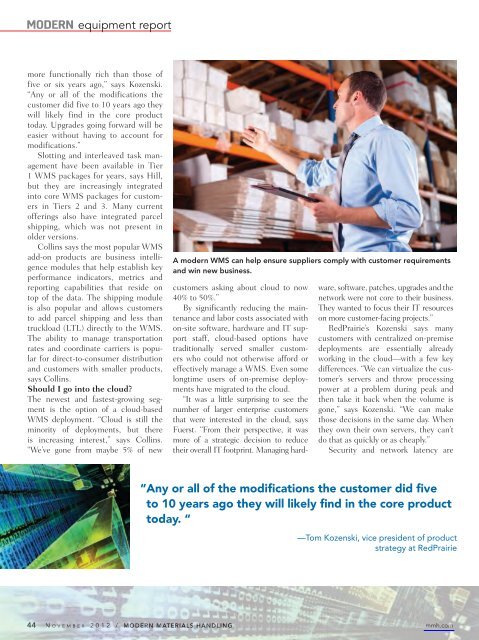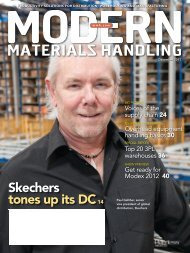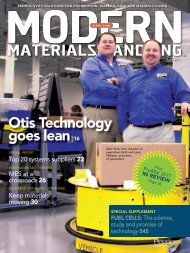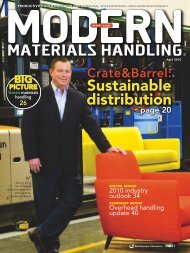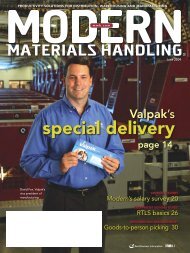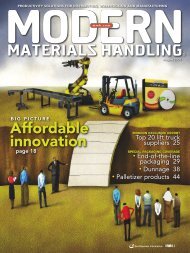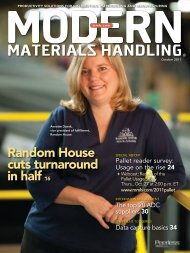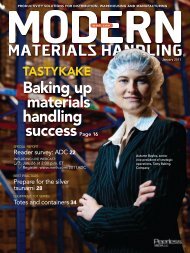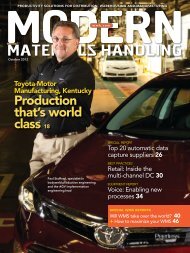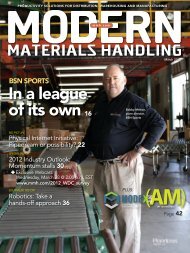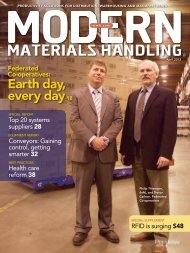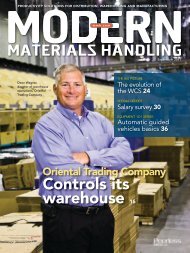Modern Materials Handling - November 2012
Modern Materials Handling - November 2012
Modern Materials Handling - November 2012
Create successful ePaper yourself
Turn your PDF publications into a flip-book with our unique Google optimized e-Paper software.
MODERN equipment reportmore functionally rich than those offive or six years ago,” says Kozenski.“Any or all of the modifications thecustomer did five to 10 years ago theywill likely find in the core producttoday. Upgrades going forward will beeasier without having to account formodifications.”Slotting and interleaved task managementhave been available in Tier1 WMS packages for years, says Hill,but they are increasingly integratedinto core WMS packages for customersin Tiers 2 and 3. Many currentofferings also have integrated parcelshipping, which was not present inolder versions.Collins says the most popular WMSadd-on products are business intelligencemodules that help establish keyperformance indicators, metrics andreporting capabilities that reside ontop of the data. The shipping moduleis also popular and allows customersto add parcel shipping and less thantruckload (LTL) directly to the WMS.The ability to manage transportationrates and coordinate carriers is popularfor direct-to-consumer distributionand customers with smaller products,says Collins.Should I go into the cloud?The newest and fastest-growing segmentis the option of a cloud-basedWMS deployment. “Cloud is still theminority of deployments, but thereis increasing interest,” says Collins.“We’ve gone from maybe 5% of newA modern WMS can help ensure suppliers comply with customer requirementsand win new business.customers asking about cloud to now40% to 50%.”By significantly reducing the maintenanceand labor costs associated withon-site software, hardware and IT supportstaff, cloud-based options havetraditionally served smaller customerswho could not otherwise afford oreffectively manage a WMS. Even somelongtime users of on-premise deploymentshave migrated to the cloud.“It was a little surprising to see thenumber of larger enterprise customersthat were interested in the cloud, saysFuerst. “From their perspective, it wasmore of a strategic decision to reducetheir overall IT footprint. Managing hardware,software, patches, upgrades and thenetwork were not core to their business.They wanted to focus their IT resourceson more customer-facing projects.”RedPrairie’s Kozenski says manycustomers with centralized on-premisedeployments are essentially alreadyworking in the cloud—with a few keydifferences. “We can virtualize the customer’sservers and throw processingpower at a problem during peak andthen take it back when the volume isgone,” says Kozenski. “We can makethose decisions in the same day. Whenthey own their own servers, they can’tdo that as quickly or as cheaply.”Security and network latency are“ Any or all of the modifications the customer did fiveto 10 years ago they will likely find in the core producttoday. “—Tom Kozenski, vice president of productstrategy at RedPrairie44 N O V E M B E R 2 0 1 2 / MODERN MATERIALS HANDLING mmh.com


